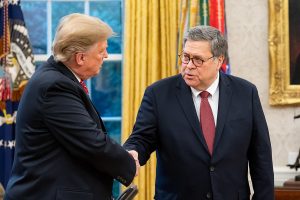by John Feffer
Donald Trump has shaken up U.S. foreign policy. Most of what he has done has been disastrous, like pulling America out of the Paris climate accord and the Iran nuclear deal. He has been erratic, unprincipled, aggressive, and unilateral.
And yet, he has also created some interesting opportunities, sometimes inadvertently, that progressives should seize. The foreign policy elite has been challenged like never before. In the most likely scenario, of course, the Blob — as President Obama liked to characterize the unthinking foreign policy consensus inside the Beltway — attempts to reestablish the status quo ante after the 2020 elections.
But maybe, just maybe, the United States could go down a different road after Trump. Here’s what that road might look like.
An End to Endless War?
The Trump administration did not depart from the dangerous U.S. military fixation on the Middle East. It finished what the Obama administration started, namely bombing the stuffing out of the Islamic State in Syria and Iraq. It ramped up drone strikes in Yemen, Somalia, and Pakistan. It forged closer relations with the autocratic and destabilizing Crown Prince Mohammed bin Salman in Saudi Arabia and supported to the hilt the right-wing lunacy of the Netanyahu government in Israel.
And yet, the endless war against terrorism started by George W. Bush may finally be coming to an end. The Trump administration is eager to pull troops out of Afghanistan, the longest war in U.S. history. Late last year, Trump instructed the Pentagon to withdraw half of the 14,000 American troops in that country, but the Pentagon convinced him ultimately to go slow. The same applies to Syria, where Trump impulsively announced a troop withdrawal only for his hawkish advisors to walk back that plan.
The important message in all this, however, is that the days of surges are over. The American public has not had any appetite for boots on the ground in the Middle East for some time. The drawdown might be faster or slower, but the tide is receding. In Afghanistan, a peace process, however flawed, may provide the cover necessary to end U.S. military involvement. In Syria, the United States is gradually accepting the continuity of Bashar al-Assad’s repressive but resilient regime. Iraq limps along, but it has survived even after the bulk of American troops have left the country and is even repairing its relationship with Iran.
Meanwhile, Congress is finally asserting itself. Last week, the Senate passed a bill mandating the withdrawal of U.S. forces from the war in Yemen. For the first time since the passage of the War Powers Act in 1973, both chambers have declared that the United States should exit an overseas conflict.
But that’s not all. There’s finally a good chance that Congress will repeal the bill that started it all: the 2001 Authorization for the Use of Military Force (AUMF). At the time of its passage, the only congressional representative brave enough to say no was Barbara Lee (D-CA). She’s still in Congress leading the fight to revoke the AUMF. As a result, for the first time in a decade, Congress will have an opportunity to debate the full range of U.S. military interventions. Six members of Congress, including presidential hopefuls Elizabeth Warren and Bernie Sanders, have also signed a pledge to “end the forever wars.” This pledge should become a litmus test for all Democratic presidential candidates.
Trump is no pacifist. But his skepticism about the wars initiated by his predecessors has opened up a debate on U.S. militarism, particularly in the Middle East and surrounding areas. Progressives need to seize this opportunity and make sure that liberal hawks don’t join hands with conventional militarists to reverse this trend after 2020.
China, Russia, and Military Spending
But here’s the rub. The Pentagon is not focused on the Middle East. In a very real sense, the Pentagon has moved on from the wars of the 2000s. It has refocused for some time on China and, to a lesser extent, Russia, the two “revisionist powers” that Trump’s National Security Strategy identifies as key threats to the United States. And if that weren’t enough, the Pentagon is also gearing up to address a range of new threats like cyberwarfare and space combat.
So, even as momentum gathers to end the forever wars, the Pentagon is looking at a major increase in its budget to fight other conflicts. Trump wants to boost military spending to $750 billion. The Dems are willing to settle for a more modest increase to $733 billion. Either way, it’s way too much.
The bulk of this spending is directed at preventing China, the only major power with a military remotely the size of America’s, from becoming number one. Indeed, the Trump administration is engaged in a full-court press on Beijing. In the South China Sea, the U.S. navy is conducting “freedom of navigation” exercises specifically designed to send a “back off” signal to China. Meanwhile, Trump has initiated a trade war of escalating tariffs with Beijing and has gone all out to pressure allies to freeze China out of the latest telecom upgrades. The cooperation between Washington and Beijing on environment and energy that flourished during the Obama years is dwindling.
But here, too, Trump’s moves offer progressives a few opportunities. With his face-to-face meetings with North Korea’s Kim Jong Un, Trump has shown at least some willingness to end the most dangerous Cold War divide in Asia between North and South Korea. Though Trump’s overtures can also be understood as a tactic to drive a wedge between Pyongyang and Beijing, progressives should seize upon the ongoing peace discussions as a golden opportunity to regionalize the issue.
Rapprochement with North Korea could be the key to unlocking the problem of East Asian security, not just the ongoing territorial conflicts around various islands but also the larger stand-off between U.S. allies and China. Japan recently invested heavily in China’s Belt and Road Initiative, and South Korea is eager to facilitate a de-escalation of tensions region-wide. The Democrats are clueless about all of this, or actively hostile (because they dislike everything Trump does). Progressives, on the other hand, must raise up this peace process on the Korean peninsula as a way to defuse a new and potentially explosive conflict between Washington and Beijing.
Trump’s efforts to reset U.S.-Russian relations are, of course, complicated by the president’s complicity in Moscow’s interference in the 2016 elections. But here, too, progressives should focus on where the interests of Washington and Moscow converge, such as arms control or engagement with Iran. A return to good, old-fashioned diplomacy, when the United States negotiated in good faith with adversaries like Cuba and Iran as well as Russia and China, should again become a centerpiece of U.S. foreign policy.
The military budget is a tough nut to crack. Americans generally favor a reduction in the Pentagon’s budget, but the political process still heavily favors the military-industrial complex. So does Trump, though even here the president has shown a way out. His declaration of a national emergency entails a direct siphoning of funds from the Pentagon to pay for his beloved Wall.
Trump’s emergency is bogus, the Wall a chimera. But Trump’s move is a reminder that the Pentagon budget is not sacrosanct. America is beset by several authentic emergencies: climate change, collapsing infrastructure, drug epidemics, deteriorating public education. For years, realists have argued that money from the Pentagon can’t just be transferred to other purposes. Well, maybe it can. The next administration just has to rally the country around the true emergencies that America faces.
Going It Together
Trump’s America First rhetoric and actions appeal to a certain segment of America. But most Americans see the value of the United Nations, of working with allies, of engaging in multilateralism. Indeed, Trump’s foreign policy record should produce immediate nostalgia for the various examples of cooperative U.S. foreign policy in the past, from the creation of the United Nations all the way up to Iran nuclear agreement.
Here, Trump has not shown the way. He has proven what a dead-end unilateralism is. The world has become a decidedly more dangerous place in the last two years.
Moreover, Trump’s unilateral actions have largely reinforced the determination of other international actors to preserve what the United States has tried to tear asunder. The Europeans have scrambled to maintain the Iran nuclear agreement. China and others are stepping forward on climate change. All the other signatories of the Trans Pacific Partnership have signed the treaty and moved on. The UN Human Rights Council has continued to operate after the United States withdrew last summer. In fact, earlier this month, it issued its first ever statement rebuking Saudi Arabia, an initiative spearheaded by Iceland, which replaced the United States.
Liberal internationalists wring their hands about the loss of American “leadership.” I’m not so concerned about this issue. American leadership has as often had a negative global impact as a positive one. More important is the opportunity for a global rebalance. The United States is no longer the global rule-setter. Other countries are stepping forward to exert global influence: China and the EU, of course, but also Russia, Turkey, and India.
Trump has inadvertently strengthened the case for the United States to play a more modest role in international relations. Progressives have to build on this new global modesty by pushing for the United States to engage in a global conversation about governance: how best to marshal international energies to address major problems such as climate change, pandemics, and economic inequality. That conversation must begin with a reset of relations with China.
The Global Economy
There’s a major problem in all this talk of global governance. Most of the leading players are thoroughly illiberal: China, Russia, India, Turkey, Brazil, even parts of the EU.
If given a chance, these countries are likely to rewrite the rules of the international road to prevent global bodies from challenging human rights violations within their sovereign borders. The current administrations in Moscow, Beijing, Ankara, New Delhi, Brazilia, Budapest, and (alas) Washington show a preference for strong-arm leadership. They are frequently anti-immigrant and/or intolerant of ethnic and religious minorities.
A major source of this new illiberal sentiment is a dissatisfaction with the results of economic globalization. Tremendous wealth has been created as a result of increased trade, more rapid movement of money and financial services across borders, and the creation of global assembly lines for products.
Much of that wealth has remained concentrated in relatively few hands. Last year, for instance, the wealth of the poorest half of humanity dropped by an astonishing 11 percent while billionaires increased their holdings by 12 percent. The 26 wealthiest people in the world now own as much as the poorest 3.8 billion people. It’s not just action at the edges, but also the hollowing out of the middle: the disappearance of well-paid jobs for the middle class in industrialized countries.
This raging inequality — and the raging against inequality — stems from the economic policies of liberals and conservatives alike. The major parties of the center all embraced some form of neo-liberal economic reform — less government, less regulation, less oversight, more unfettered market. So, it’s no wonder that the disgruntled have rejected the conventional political parties. But instead of supporting progressive alternatives to neoliberal economics, the electorate has gravitated toward right-wing populism.
Here again, the bankruptcy of Trump’s populism is an extraordinary opportunity for progressives. Trump has not helped out the heartland. He’s given handouts to the rich through his tax cuts and ushered in a whole new set of lobbyists to populate the swamp of Washington.
With a Green New Deal, progressives offer a powerful response to Trumpian populism: a large-scale infrastructure plan that creates good jobs, repairs America’s infrastructure, and reduces the country’s carbon footprint. America’s liberal economic trajectory was built on some of the worst kind of industries: oil, coal, military. Trump’s solution has been to double down on these very same sectors. Progressives need to offer a clear, positive, and Green alternative.
The Fear Factor
Trump rode a wave of fear into the White House. He made it seem as if immigrants were about to storm the country. His casual racism also endeared him to the alt-right and white supremacists. As president, he has simply raised all of that fear and loathing to a global level with his talk of “shithole countries,” his Muslim travel ban, and his obsessive focus on his Wall.
In the long run, Trump could very well represent the last gasp of white male privilege in a country that will soon enough be majority non-white (circa 2045) and where women are making huge political and economic gains (capturing a record 24 percent of congressional seats in 2018).
Progressives should, of course, counter all of these racist and sexist rearguard actions with calm, fact-based analysis.
But progressives should also recognize that emotions bring people out to the polls. Progressives should not be hesitant about exploiting the fear factor as well. We just have to focus on where Americans’ true anxieties lie.
Progressives have to focus on the fear of an extreme weather event wiping out a large swath of the United States. We have to focus on the legitimate fear that people have of losing their jobs or being unable to pay off their debts. We have to focus on the very rational fear of gun violence.
And, of course, progressives need to join with lots of other political actors in the United States to capitalize on the widespread fear that Donald Trump — or someone very much like him — could win the presidential election in 2020.
Liberals have too often supported U.S. military interventions, huge levels of military spending, American exceptionalism on the world stage, economic policies that have torn apart communities, and the politics of white privilege that have tarnished the democratic reputation of this country.
This particular liberal trajectory is a dead end. And so is Trump’s purported alternative.
America is ready for something new. Progressives now have an opportunity to take advantage of what Trump has done (and not done) as well as the widespread disgust with the failures of liberal politics as usual to remake America and America’s place in the world.
Republished, with permission, from Foreign Policy In Focus.





